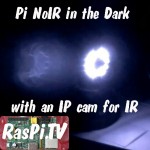Oct 312013

After trying out the new Pi NoIR camera in a daylight comparison, it was time to test it for its main role. Apart from specialist applications in botany, etc. the “killer app” for Pi NoIR is night vision.
You need an infra-red source to illuminate the target area. The only one I had to hand was an IP cam, which has a light sensor on it and ten infra-red LEDs. When it starts to get dark, the leds switch on. I’ve got another IR source on the way from Phenoptix, which I plan to dedicate to Pi NoIR usage.
But in the meantime, here’s the results of the first “in the dark” experiment…
Can’t remember whether I was wobbling on this site about IR stop filters for the NO-IP to make it useable in daylight – I had an idea about a servo swinging it into position at night…or maybe I just warmed up the resistor attached to to /dev/null…
Anyway, I’ve looked but can’t find. As imagemagick, OpenCV etc, have tricks up their sleeve more than my ancient mind can grasp, is there any reason why an IR image can’t be reprocessed to give a ‘normal’ image? Even if it took awhile…
Just a thought.
From just a raw image, there’s no way to tell what’s “red” in normal light, and what’s IR-light. The sensor detects them both the same with the red-pixels on the image sensor.
So I believe the answer is no, it can’t be post-processed.
I just thought of something. On NASA rovers there is always a reference colour pattern somewhere the camera can see so they can calibrate that day’s images. Perhaps a known red/green/blue strip could be placed somewhere at the edge of the field of view, and post processing could aim to change the entire image so that those three colours matched the known RGB numbers?
I think you’d still end up with strange-looking images, since everything would be made “more red” by the infra-red light which humans can’t normally see.